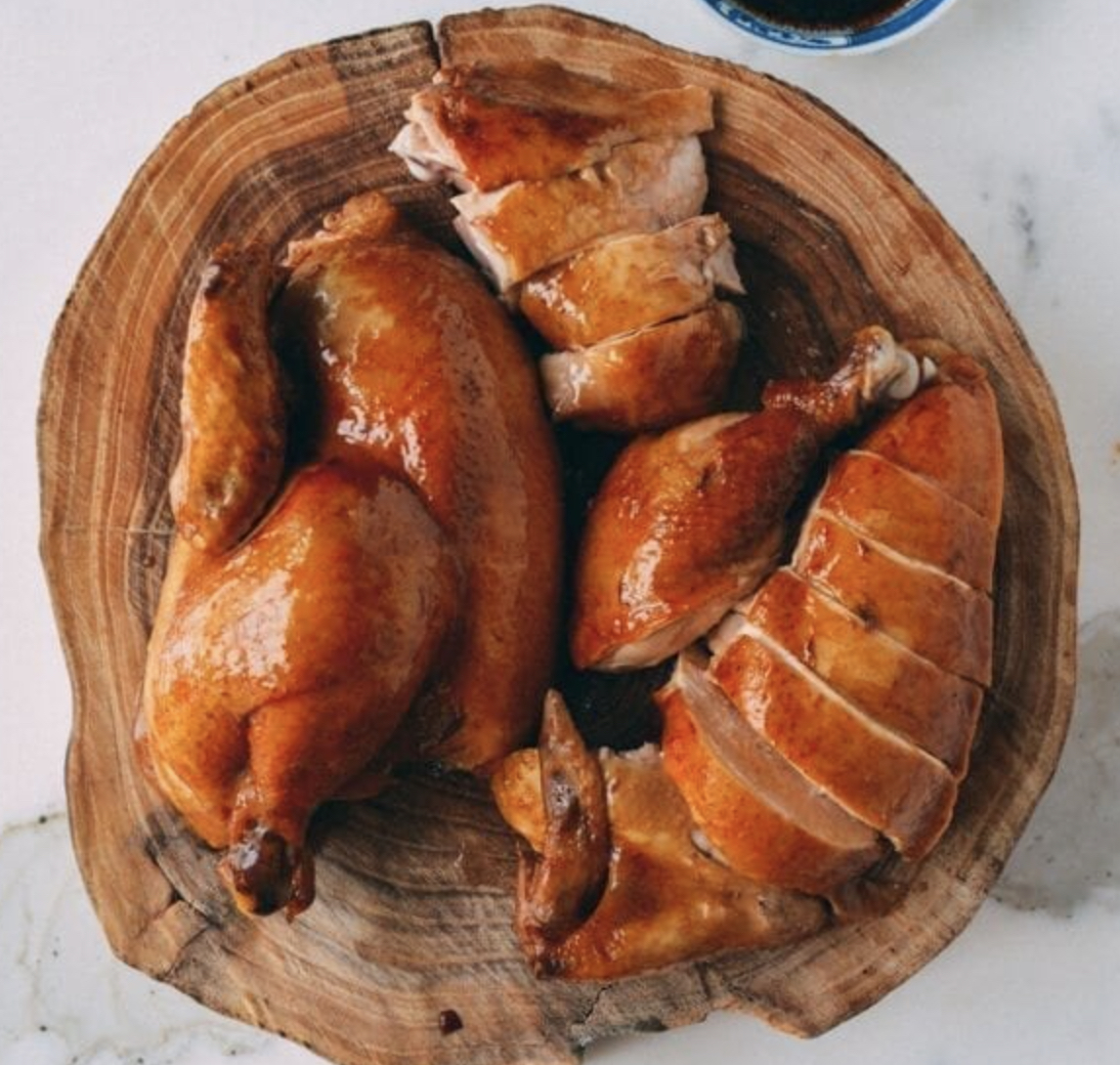 Pin
Pin
This Chinese braised chicken takes an ordinary bird and turns it into something special with its rich flavor and tender texture—it looks just like those shiny chickens hanging in Chinatown windows. When you slowly cook it in an aromatic soy mixture, you'll get that glossy skin and juicy meat that makes this classic dish worth trying at home.
I tried making this for the first time after coming back from a trip to Hong Kong where I couldn't get enough of these flavors. It took me several tries to get it right, but now this dish shows up on our table about once a month and everyone gets excited when they see it coming.
What You Need
- Whole chicken: Around 4 pounds, try to get free-range since better quality meat takes up more of the taste
- Fresh ginger: Grab pieces that feel firm with smooth skin for that warm spicy base
- Scallions: They add a mild oniony kick without being too strong, pick ones with bright green tops
- Whole star anise: Those star-shaped spices with their sweet licorice flavor are key to authentic taste
- Chinese rose wine or Shaoxing wine: Brings richness to the dish, try to find the real stuff
- Regular soy sauce: This is your main salty element, be careful not to add too much
- Dark soy sauce: This gives that beautiful brown color, look for actual Chinese brands
- Sugar: Adds a touch of sweetness and helps with browning, plain white sugar works fine
- Aromatics, oil, salt and water: These round everything out, clean filtered water is best if you have it
How To Make It
- Get Your Chicken Ready:
- Let your chicken sit out for about an hour before you start. This helps it cook more evenly. Clean it inside and out, take out any giblets, and pat it dry with paper towels. Letting the skin dry a bit helps the sauce stick better.
- Start The Flavor Base:
- Pour some oil into a tall pot that's just big enough for your chicken. Throw in the ginger and let it cook until it starts to turn brown and smell good, which takes about half a minute. Toss in the crushed scallions and give them a quick 30-second cook until they smell nice too.
- Make The Sauce:
- Drop in the star anise and pour in the wine, then let it bubble gently for 3 minutes so the alcohol cooks off. Add both kinds of soy sauce, the sugar, salt, and water, and stir until all the sugar dissolves. Let this simmer for a full 20 minutes to build up all those tasty flavors.
- Start Cooking The Chicken:
- Turn up the heat a bit to get a gentle boil going. Stick a big fork into the chicken cavity and lower it in breast-side up so it's fully covered with liquid. After 5 minutes, lift the chicken up to drain any liquid from inside, then put it back in the pot.
- Slow Cook And Rest:
- Keep it at a very gentle simmer (never a hard boil or the meat will get tough) for about 25 minutes. Try to keep the temperature around 210°F. Then turn off the heat, put the lid on, and let the chicken sit in the hot liquid for another 15 minutes. This slow cooling makes the meat super tender.
- Finish It Off:
- Move the chicken to a cutting board and spoon some cooking liquid over it now and then to keep it moist and shiny. Let it cool for about 15 minutes until you can handle it. Then either chop it through the bones Chinese-style or carve it into neat pieces Western-style.
This dish always takes me back to my grandma's Sunday dinners. She'd cook this chicken early in the morning and let it sit until mealtime. The star anise always caught my attention as a kid—I loved how it looked and smelled so interesting. Now I get why she always used the whole stars instead of powder: they slowly release flavor in a way that powder just can't match.
About The Special Sauce
The liquid left after cooking is what Chinese cooks call "master sauce" or "lo sui." This flavor-packed stuff actually improves with each use, building up tastes you can't get from just one cooking session. After you're done, strain the liquid and put it in freezer containers. Next time you want to make this dish, just thaw it out, boil it for safety, adjust the seasonings if needed, and use it again. Some Chinese families keep these sauces going for years or even pass them down through generations, adding fresh spices each time.
What To Serve With It
This chicken goes great with plain white rice that soaks up all that tasty sauce. For a full meal, add some bok choy or gai lan cooked with a bit of oyster sauce and garlic. The traditional side is a small dish of chopped ginger and scallions mixed with a bit of salt and hot oil, which cuts through the richness of the chicken. A light soup like winter melon or egg drop rounds out the meal perfectly.
Swap Options
Can't find Chinese rose wine? Dry sherry works pretty well though it's not quite the same. If you don't want to use alcohol at all, try chicken broth with a spoonful of rice vinegar for that tangy kick. You can swap in coconut sugar for regular sugar if you want a deeper flavor. While you really need dark soy sauce for that nice color, in a pinch you can mix regular soy sauce with a teaspoon of molasses. Free-range chickens taste best, but any whole chicken will do—just cook it about 10 minutes longer for each pound over 4 pounds.
Recipe Q&A
- → What other chicken cuts can I use?
You can go for chicken thighs or leg quarters for a quicker cook. Just adjust the timing to ensure they’re done properly.
- → What kind of pot works best?
A deep, narrow stockpot is ideal since it lets the chicken sink completely in the sauce without needing tons of liquid.
- → Is it okay to save the sauce?
Absolutely, freeze it for another meal. When reusing, freshen it up with seasoning to bring back its richness.
- → How do I check if the chicken’s done?
Use a meat thermometer on the thickest part of the thigh. It’s ready when it hits 165°F.
- → What’s the best way to serve it?
Chop up the chicken and dish it up on rice. Pour some of that delicious sauce over the top for maximum flavor.
